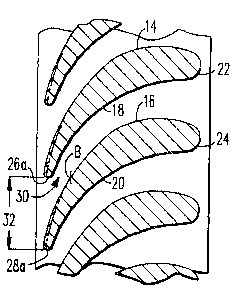Some of the information on this Web page has been provided by external sources. The Government of Canada is not responsible for the accuracy, reliability or currency of the information supplied by external sources. Users wishing to rely upon this information should consult directly with the source of the information. Content provided by external sources is not subject to official languages, privacy and accessibility requirements.
Any discrepancies in the text and image of the Claims and Abstract are due to differing posting times. Text of the Claims and Abstract are posted:
| (12) Patent Application: | (11) CA 2044027 |
|---|---|
| (54) English Title: | CONTROL STAGE NOZZLE VANE FOR USE IN PARTIAL ARC OPERATION |
| (54) French Title: | AUBE DIRECTRICE D'ETAGE DE COMMANDE POUR EXPLOITATION EN MODE "ARC PARTIEL" |
| Status: | Deemed Abandoned and Beyond the Period of Reinstatement - Pending Response to Notice of Disregarded Communication |
| (51) International Patent Classification (IPC): |
|
|---|---|
| (72) Inventors : |
|
| (73) Owners : |
|
| (71) Applicants : |
|
| (74) Agent: | SMART & BIGGAR LP |
| (74) Associate agent: | |
| (45) Issued: | |
| (22) Filed Date: | 1991-06-06 |
| (41) Open to Public Inspection: | 1991-12-08 |
| Examination requested: | 1998-06-04 |
| Availability of licence: | N/A |
| Dedicated to the Public: | N/A |
| (25) Language of filing: | English |
| Patent Cooperation Treaty (PCT): | No |
|---|
| (30) Application Priority Data: | ||||||
|---|---|---|---|---|---|---|
|
55,711
ABSTRACT OF THE DISCLOSURE
For steam turbines capable of being operated in
partial arc operation, the primary arc of admission is
provided with nozzle vanes having a thicker trailing
edge as compared to the trailing edges of the remaining
nozzle vanes, so that chipping and erosion due to a
large pressure load during partial load operation is
avoided.
Note: Claims are shown in the official language in which they were submitted.
Note: Descriptions are shown in the official language in which they were submitted.

2024-08-01:As part of the Next Generation Patents (NGP) transition, the Canadian Patents Database (CPD) now contains a more detailed Event History, which replicates the Event Log of our new back-office solution.
Please note that "Inactive:" events refers to events no longer in use in our new back-office solution.
For a clearer understanding of the status of the application/patent presented on this page, the site Disclaimer , as well as the definitions for Patent , Event History , Maintenance Fee and Payment History should be consulted.
| Description | Date |
|---|---|
| Inactive: IPC from MCD | 2006-03-11 |
| Application Not Reinstated by Deadline | 2003-06-06 |
| Time Limit for Reversal Expired | 2003-06-06 |
| Deemed Abandoned - Failure to Respond to Maintenance Fee Notice | 2002-06-06 |
| Inactive: Final fee received | 2002-03-27 |
| Pre-grant | 2002-03-27 |
| Notice of Allowance is Issued | 2001-09-27 |
| Notice of Allowance is Issued | 2001-09-27 |
| Letter Sent | 2001-09-27 |
| Inactive: Approved for allowance (AFA) | 2001-09-04 |
| Amendment Received - Voluntary Amendment | 2001-07-04 |
| Inactive: S.30(2) Rules - Examiner requisition | 2001-01-09 |
| Letter Sent | 1998-06-23 |
| Inactive: Status info is complete as of Log entry date | 1998-06-23 |
| Inactive: Application prosecuted on TS as of Log entry date | 1998-06-23 |
| Request for Examination Requirements Determined Compliant | 1998-06-04 |
| All Requirements for Examination Determined Compliant | 1998-06-04 |
| Application Published (Open to Public Inspection) | 1991-12-08 |
| Abandonment Date | Reason | Reinstatement Date |
|---|---|---|
| 2002-06-06 |
The last payment was received on 2001-05-18
Note : If the full payment has not been received on or before the date indicated, a further fee may be required which may be one of the following
Please refer to the CIPO Patent Fees web page to see all current fee amounts.
| Fee Type | Anniversary Year | Due Date | Paid Date |
|---|---|---|---|
| MF (application, 7th anniv.) - standard | 07 | 1998-06-08 | 1998-03-23 |
| Request for examination - standard | 1998-06-04 | ||
| MF (application, 8th anniv.) - standard | 08 | 1999-06-07 | 1999-06-04 |
| MF (application, 9th anniv.) - standard | 09 | 2000-06-06 | 2000-05-26 |
| MF (application, 10th anniv.) - standard | 10 | 2001-06-06 | 2001-05-18 |
| Final fee - standard | 2002-03-27 |
Note: Records showing the ownership history in alphabetical order.
| Current Owners on Record |
|---|
| WESTINGHOUSE ELECTRIC CORPORATION |
| Past Owners on Record |
|---|
| MANK HAI TRAN |